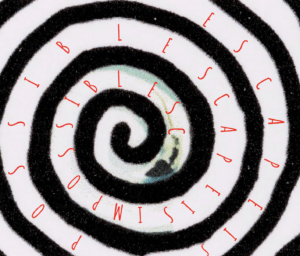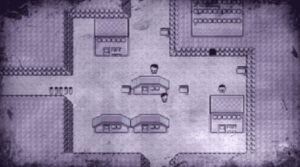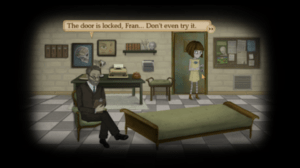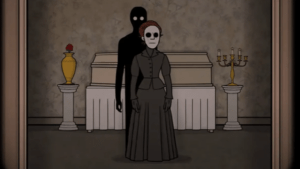Intro

For years, nothing changed at Erevere Hospital. Day blended into identical day.
But today, something is different. Your cell door, always locked, is now slightly open.
Curiosity overcomes you. You step out. The corridor loops endlessly, each step peeling back layers of forgotten horrors.
Your own spiral into madness begins here.
Tone
The game tone is dark and mysterious, filling players with a sense of dread, yet the mysteries of the ward are so compelling that you can’t help but continue.
Unsettling: By including slight differences in dialogue and appearance between the different floors, we hope to make the players question their own sanity – did they really not see this picture before, or is that just their imagination? Is that really the same NPC that they’re talking to?
Trapped: The enclosed, looping layout of the psych ward intensifies feelings of entrapment and heightens the psychological tension. As players continue to progress through the game, they may begin to feel
The Story & Setting
The game takes place in Erevere Hospital, a psychiatric hospital that no one has stepped into for years. The door of every patient’s cell is always closed. One day, the player, one of the patients, wakes up in his/her dark cell, and finds that his/her door is slightly opened and there is a note in the corner saying “LEAVE!”. He/she walks into the corridor, which seems to be an endless loop. No one is in the corridor, and everything seems to be scary. The player can only see other people in their own cells from their window.
When the player walks through the whole loop, they will realize that something has changed – they go to the next level of the corridor loop in this way. Each level of the corridor has some differences from others in both art style and puzzles to solve. The players can interact with NPCs from the windows of their cells if he/she sees them, and also solve puzzles on the walls to unlock the story behind the hospital.
Gradually, the player will find that the corridor becomes bright and cozy compared to the original dark, prison-style cells. In the end, the player does not find any way out, and after the game ends, the scene cuts to black. In the final cutscene, the player wakes up in their cell, but this time it is not unlocked, and they see another character next to them, with an unlocked cell. It is unclear whether the player’s character retains their memories of the experience.
We hope to create a game where the player is walking in a seemingly endless loop, interacting with the NPCs and solving puzzles to discover the story behind the hospital and go to the next level. There are slight differences in each level, and the art style gradually shifts from black-white and scary to colorful and cozy. In this story and setting, we hope to emulate the process of becoming a psychopath and non-sense, while the player will only know this at the end when the scene becomes black and white, and he/she witnesses another character walk out of an unlocked cell.
Gameplay
Our core gameplay is exploring the hospital and interacting with different patients and the environment.
The story will use third-person controls. Players can navigate through each level of the loop with only up and down keys to move the characters. It makes the gameplay feel like they are in a loop in one level of the hospital but it is actually a spiral, so the player would be on the next level when they navigate to the starting point(their ward).
Players can interact with different patients and solve the puzzles by clicking or keystrokes. Mechanics that we think are:
- Players can talk to other patients by clicking on the patient.
- Players can solve puzzles by clicking on the puzzle and entering keys/passwords, the correct clue to the puzzle should be found on other levels.
- Patients are clones of each other from different levels, so they will not have memories of previous levels.
- Players can make changes (pressing buttons, unlocking doors, etc.), but if they go through a full circle, they will be on a different floor, so they will not see that change unless they go back.
Tone References
Song of Horror (all puzzles, no combat)

Pokemon (Lavender Town – notoriously unsettling location in otherwise friendly pixelated game)

Fran Bow (progressive theming, gets more dark/ominous as you advance)

Upstairs (looping horror game)

Rusty Lake (creepy but important NPCs)

Stardew Valley (2D game with a cozy art style. For upper levels where the style becomes cozy and warm).

Key Challenges
Design
- Structuring the logic of the game: Design the cohesive logic and flow to make players notice or assume firstly that they are going in a loop, but progressively notice that they are actually in the spiral structure to solve all the puzzles.
- Being immersive and cohesive in the psychological hospital setting throughout the gameplay
- Level of difficulties: We need to design the game for the player to feel confused at the beginning to be involved but not too confused to lose interest in the game, and let them progressively figure out what is happening by designing the conversations/puzzles/environments.
Tech
- Three of us do not have any experience in using game engines to develop digital games. So, there are also challenges to learning to code with game engines.
- Difficulties might also arise when we want to merge our codes when cooperating given the unfamiliar coding environment.
- Also, having to program many versions of each NPC and puzzle (one for every different floor) will be difficult, especially since we must keep in mind that not all of them will have interacted with the player in the same way, and thus may have different “memories” of what the player has done at a certain point. In addition, keeping track of who has seen what from the player may be difficult。
Art
- Different designs of each level: to make the levels feel like they are in a loop, but there are small differences to indicate actual level differences. Also, we want to involve changing the art style (from dark to cozy) to mimic the process of losing their senses, which needs specific designs.
- Being scary/immersive in the psychological hospital setting: make the experience from level to level just slightly different enough to make players question their own memory, not being so repetitive that players don’t notice that nothing’s wrong, but not so obvious that players are hit in the face with obvious differences.
Who is this for?
The game is intended for enthusiasts of horror and psychological thriller games. It’s ideal for players who seek to explore enigmatic settings through several puzzles and challenges. Because the game promises to deliver a compelling and unsettling adventure, we also want players to be able to pick up on the complex narratives and meanings behind the game’s storyline, which means that Spiraling would best appeal to players 16 and older.
Individual Concept Docs
- https://mechanicsofmagic.com/2024/05/05/p2-individual-deliverables-bihan/
- https://mechanicsofmagic.com/2024/05/05/p2-checkpoint1-individual-deliverables-yuren-sun/
- https://mechanicsofmagic.com/2024/05/06/p2-individual-brainstorm-arnav-krishnamoorthi/
- https://mechanicsofmagic.com/2024/05/06/p2-individual-checkpoint-1-ian/




